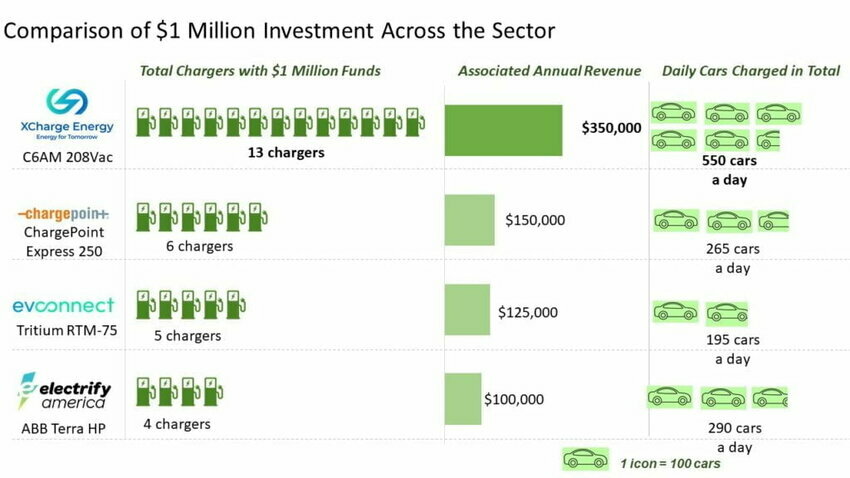 (Photo: Electric vehicle utilizes a public charging station. Credit: XCharge North America.)
(Photo: Electric vehicle utilizes a public charging station. Credit: XCharge North America.)Last week, the Biden administration launched its latest plans for electrifying the great American road trip. With a vision of building 500,000 electrical vehicle (EV) chargers by 2030, the Build America, Buy America implementation plan focuses on creating a nationwide network of EV chargers that are maintained and manufactured by American workers.
As states move to ban the sale of new gas-powered vehicles, this boost to EV charging infrastructure is crucial for consumer adoption. In a recent J.D. Power study on the public charging experience, the shortage of public charging availability is the number one reason shoppers avoid EVs. Access to charging stations varies significantly across state lines, and currently, not all chargers and EVs are interoperable. Tesla is known for its well-maintained EV chargers, but until very recently, its Supercharger network was not accessible to non-Tesla vehicles.
“Not only is the availability of public charging still an obstacle, but EV owners continue to be faced with charging station equipment that is inoperable,” said Brent Gruber, executive director of global automotive at J.D. Power. “Stations need to be added to areas where there are currently gaps in heavily traveled routes and in high-density areas for people who don’t have access to residential charging, but most importantly, designed with things for users to do while charging—regardless of the use case. Then, we need to make sure those stations are reliable.”
A key tactic in the Biden administration’s proposal is the development of national standards to ensure that chargers operated by different networks will operate similarly – no matter the car or location. These standards will also require consistent plug types, charging speeds, and common payment systems. This effort standardization is already in motion with Tesla’s recent deal with the White House to open up 3,500 Superchargers to all EVs.
This is extremely promising, but many are concerned about the feasibility of a national network that is dependent on domestic supply. Also, as part of this new EV package, the Bipartisan Infrastructure Law requires that all EV chargers funded by federal investment must be built in the United States – effective immediately.
“I’m all in for supporting America’s workforce and manufacturing sector in the EV revolution. That’s one the of main reasons XCharge is working on establishing a domestic manufacturing presence for our products by this year. With that said, the guidelines and timelines released by the administration definitely put us EVSE OEMs in an interesting spot,” said Aatish Patel, president, and co-founder of XCharge North America. “Resourcing, validating, pressure testing, certifying, and scaling products is an endeavor on its own... This is possible, but at what time, cost, and quality?”
While domestic production is a worthy goal, a phased approach might be a better way to ramp up infrastructure more quickly. Patel explained that EV Charger Original Equipment Manufacturers (OEMs) like XCharge are also battling a limited domestic supply chain, a shortage of skilled labor, and constant backlogs.
"It was a surprise to us that they would require assembly immediately given that domestic manufacturing for high-power charging infrastructure is starting basically from scratch. And the supply chain is very constrained,” said Jonathan Levy, a chief commercial officer of EVgo.
Not only are domestic manufacturers scrambling to keep up with demands, but OEMs also must factor in that the North American EV grid is slower and less robust than its European and Asia counterparts. This means that forecasts from examples abroad will not fit the U.S. grid, which is overdue for a voltage update. XCharge North America, a leading global EV charging provider, is working to address this obstacle to adoption through charging stations that are more resilient and maximize the existing grid.
 (Photo: Comparison of $1 million investments in EV chargers. Credit: XCharge North America.)
(Photo: Comparison of $1 million investments in EV chargers. Credit: XCharge North America.)Patel also highlighted that the approach to site infrastructure should be focused on “transit center, not gas station” locations, where customers have access to facilities, entertainment, and plenty of available chargers. Even fast-charging EV stations might require a 30-minute stop, which is a long time to wait as Consumer Reports notes that the vast majority of DC fast-charging places do not come with the same advantages as gas stations.
“However, infrastructure at sites is often limited, so installing chargers there is still no easy task. You need a lot of time, money, and work to get even a few chargers into the ground at these types of sites. Though considering that these will be high-traffic areas, you will need a lot more chargers than just the four to six that Electrify America normally installs. In many cases, creating a new site might be easier than trying to upfit sites with chargers,” said Patel, commenting on the EV charging partnership between TravelCenter and Electrify America.
Despite the logistical challenges ahead, this record federal investment in EV infrastructure does seem to be encouraging more consumer sales. In the last two years alone, EV sales have tripled and public charging ports have grown by at least 40%.